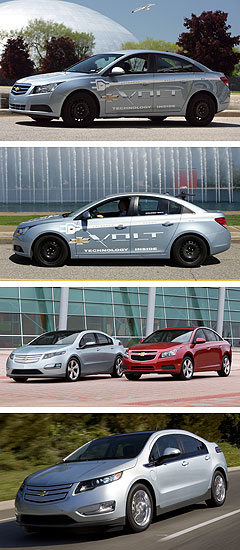Future models - Holden - Cruze - hybridGM working on Cruze hybridElectric blue: This plug-in hybrid Cruze mule wearing Volt stickers emerged in June 2009. Electrified Cruze will be a plug-in hybrid rather than a range-extender like Volt23 Nov 2011 GENERAL Motors is working on a plug-in hybrid version of the Cruze, one of Australia’s top-selling cars, to rival Toyota’s Prius plug-in. However, unlike the plug-in Volt, which will hit Holden showrooms here within a year, the electrified version of the Cruze will be a plug-in hybrid rather than an electric car with a range-extender. Strictly speaking, both models are plug-in hybrids because they combine a combustion engine with an electric motor and plug-in recharging capability, but the key difference is the Volt drives its front wheels all of the time with electric power, while the Cruze plug-in uses a combination of both petrol and electric power to do so. GM revealed a plug-in version of the Cruze with Volt running gear more than a year ago in the US, but a GM spokesman told GoAuto at last week’s Los Angeles motor show that, if it reached production, the plug-in Cruze would be a significantly different offering to the company’s image-leading Volt. “The Volt will always be a plug-in electric vehicle,” said Jim Federico, executive director, group vehicle line director and VLE for global compact, mini, small and EV. “Plug-in Cruze doesn’t make Volt redundant at all. Plug-in Cruze would have a different powertrain. Plug-in hybrids use both the engine and motor all the time.”  Left: Cruze plug-in hybrid mule. Below: Volt. Left: Cruze plug-in hybrid mule. Below: Volt.Mr Federico said that unlike the Volt – which incorporates an internal combustion engine solely to replenish the car’s lithium-ion battery pack, thereby extending its driving range – the plug-in Cruze would be a hybrid with external charging capability, like the Prius PHEV. “The plug-in Cruze has a place and it will be a hybrid,” he said. The plug-in Prius replaces the standard model’s nickel metal hydride battery with a 5.2kWh Li-Ion battery with remote charging capability, thereby increasing its electric-only driving range from about 2km to 20km. The Prius PHEV, which will return European combined fuel consumption of just 2.2L/100km and CO2 emissions of only 49g/km, goes on sale in Japan, Europe and North America next year, but remains under study for Australia. The Volt, meantime, is ‘fuelled’ by a 16kWh li-ion battery, giving its electric motor a zero-emissions driving range of about 60km, after which a 63kW 1.4-litre petrol engine kicks in to generate electricity and extend the driving range to about 480km. Under new testing protocols in the US, the Environment Protection Agency (EPA) rates the fuel economy of the Volt at 93 miles per gallon (2.5 litres per 100km). The 16kWh batteries – which are guaranteed by GM for eight years or 160,000km – can be charged at home or work in about three hours on a 15-amp outlet, meaning most commuters will rarely need to fill up with petrol. In fact, some Volt owners in the US, where GM’s ground-breaking plug-in hybrid has been on sale since December last year, have racked up 16,000km without needing to refuel. Anticipating this situation, GM has incorporated a warning light that alerts drivers after a certain mileage or about a year without refilling to prevent stale fuel damaging the engine. Separately, GM last September announced the start of field trials of an all-electric version of the Cruze sedan in Seoul, the capital of South Korea, which also produces the Cruze. The demonstration project, which GM said aimed to explore the market requirement and customer acceptance of battery-electric vehicles in the giant Asian city from last October, involved a fleet of Cruze EVs developed by GM and LG. The Cruze EV can travel up to 160km on a single charge, matching Australia’s first mass-market EV, the Mitsubishi i-MiEV, and easily exceeding the Volt. The first Volt arrived in Australia about a month ago for evaluation purposes before going on sale here around October 2012. Without the tax breaks and other incentives offered in the US, Europe and elsewhere, the Holden Volt price is expected to top $60,000 in Australia – almost double the price of the Chevrolet version in the US when full tax breaks are applied – despite the fact Holden does not expect to profit from the first-generation Volt. However, the local future of the plug-in Cruze is not known. When it announced Australian production of the Cruze two years ago, Holden said its locally built small-car would have hybrid, LPG, CNG and E85 ethanol capability. The Cruze and Volt (and Opel Astra) are built on the same GM Delta II global small-car platform, making it technically possible to produce both vehicles – in all their powertrain configurations – in Adelaide. The Volt is currently only built in Michigan, but Mr Federico said GM is “prepared to build Volt outside the US, but will let the market decide”. “We can build the Volt anywhere we build Delta cars,” he said. The Volt hit a hurdle recently in the US when one caught fire after a side pole crash test by the official National Highway Traffic Safety Administration (NHTSA). But GM hit back by accusing NHTSA engineers of failing to follow GM safety protocols to “de-energise” the lithium-ion battery after the test. Mr Federica described the situation as both a serious issue and a “non-issue”, because GM had built a plethora of fail-safe functions into the Volt and safety procedures have now been established to prevent similar incidents with electrified vehicles like the Volt. “The only new news to come out of this is you’ve got to follow protocols,” he said. “The NHTSA did nothing wrong – the protocol wasn’t developed yet. “The big deal is it’s a new technology. If you follow the protocol (after a crash), you disconnect the battery just like you disconnect the battery in a gas (petrol) car. “We’ve crashed over 80 (Volt) cars and we’ve never had an issue. We’ve trained all the first-responders. We’ve done everything we can to protect the battery. We cool the battery, we heat the battery, we don’t overcharge the battery and we’re very happy with the eight-year/100,000-mile warranty.”  Read more16th of November 2011  Volt driver Jay Leno does 16,000km on a tankUS TV host Jay Leno yet to fill up his Chev Volt after 11 months of commuting15th of November 2011  Holden goes public with 2012 VoltPlug-in Volt hits the road as Holden rips camouflage from range-extender trial cars14th of November 2011  More Cruze and less Commodore equals less profitHolden says it would need to manage costs better if Commodore is outsold by Cruze15th of August 2011  Frankfurt show: Toyota finally plugs in PriusToyota reveals production Prius Plug-In hybrid ahead of its global debut next month21st of September 2010  GM reveals Cruze EVAll-electric version of Holden’s Cruze emerges in Korea – and could be built here |
Click to shareHolden modelsResearch Holden Motor industry news |
















Facebook Twitter Instagram